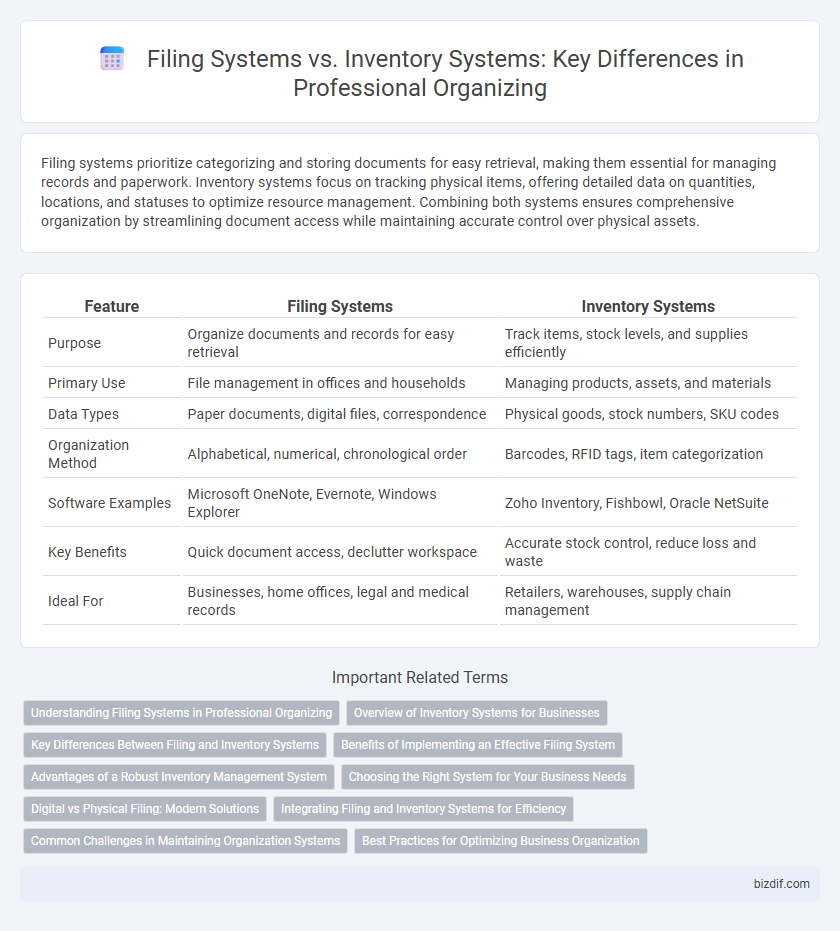Filing systems prioritize categorizing and storing documents for easy retrieval, making them essential for managing records and paperwork. Inventory systems focus on tracking physical items, offering detailed data on quantities, locations, and statuses to optimize resource management. Combining both systems ensures comprehensive organization by streamlining document access while maintaining accurate control over physical assets.
Table of Comparison
| Feature | Filing Systems | Inventory Systems |
|---|---|---|
| Purpose | Organize documents and records for easy retrieval | Track items, stock levels, and supplies efficiently |
| Primary Use | File management in offices and households | Managing products, assets, and materials |
| Data Types | Paper documents, digital files, correspondence | Physical goods, stock numbers, SKU codes |
| Organization Method | Alphabetical, numerical, chronological order | Barcodes, RFID tags, item categorization |
| Software Examples | Microsoft OneNote, Evernote, Windows Explorer | Zoho Inventory, Fishbowl, Oracle NetSuite |
| Key Benefits | Quick document access, declutter workspace | Accurate stock control, reduce loss and waste |
| Ideal For | Businesses, home offices, legal and medical records | Retailers, warehouses, supply chain management |
Understanding Filing Systems in Professional Organizing
Filing systems in professional organizing prioritize categorizing, labeling, and storing physical or digital documents for quick retrieval, enhancing overall efficiency. These systems rely on logical structures such as alphabetical, chronological, or categorical methods to streamline information access. Understanding the nuances of filing systems allows organizers to create tailored solutions that reduce clutter and improve workflow management in both office and home environments.
Overview of Inventory Systems for Businesses
Inventory systems for businesses streamline the tracking and management of stock, ensuring real-time visibility of product quantities and locations. These systems often integrate barcode scanning and automated reordering to reduce stockouts and overstock situations. By maintaining accurate inventory data, businesses can optimize supply chain efficiency and improve financial forecasting.
Key Differences Between Filing and Inventory Systems
Filing systems primarily organize documents and records by categories such as date, subject, or client, ensuring quick retrieval and efficient information management. Inventory systems track physical items with detailed data on quantities, locations, and statuses to maintain stock accuracy and streamline supply chain operations. The key difference lies in filing systems managing intangible information while inventory systems focus on tangible goods and their movement.
Benefits of Implementing an Effective Filing System
Implementing an effective filing system streamlines document retrieval, reduces clutter, and enhances overall productivity by ensuring important files are easily accessible and well-organized. Compared to inventory systems, filing systems prioritize quick information management, allowing professionals to focus on task execution rather than searching for materials. This organization method supports compliance with legal requirements and safeguards sensitive data through structured categorization and labeling.
Advantages of a Robust Inventory Management System
A robust inventory management system enhances efficiency by providing real-time tracking and reducing the risk of overstocking or stockouts, which saves time and lowers operational costs. It improves accuracy through automated data collection, minimizing human errors common in manual filing systems. This system also enables better forecasting and decision-making by delivering detailed insights into inventory trends and usage patterns.
Choosing the Right System for Your Business Needs
Selecting the appropriate system depends on your business's operational goals and the nature of your materials. Filing systems excel in managing documents, client records, and correspondence with categorization methods like alphabetical, numerical, or subject-based indexing. Inventory systems offer dynamic tracking of physical items or product stock, enabling real-time updates, barcode scanning, and automated reorder alerts, making them indispensable for retail or manufacturing environments.
Digital vs Physical Filing: Modern Solutions
Digital filing systems offer advanced search capabilities, cloud storage integration, and real-time collaboration, enhancing efficiency and accessibility compared to traditional physical filing methods. Physical filing remains essential for sensitive documents requiring legal compliance and tangible backup, often organized through labeled folders, cabinets, and inventory logs. Combining digital and physical filing systems creates a hybrid approach that streamlines document retrieval while maintaining security and regulatory adherence in professional environments.
Integrating Filing and Inventory Systems for Efficiency
Integrating filing systems with inventory systems enhances efficiency by streamlining document retrieval and asset tracking into a unified process. This combination reduces redundancy, minimizes errors, and accelerates access to critical information and items. Implementing digital platforms that sync filing classifications with inventory databases optimizes workflow and supports real-time updates for inventory management.
Common Challenges in Maintaining Organization Systems
Filing systems often face challenges such as mislabeling, inconsistent categorization, and accumulation of outdated documents, leading to reduced efficiency. Inventory systems struggle with errors in tracking, lack of real-time updates, and difficulty in managing large volumes of items, causing inaccurate stock levels. Both systems require regular audits, clear protocols, and user training to maintain accuracy and functionality in professional organizing.
Best Practices for Optimizing Business Organization
Filing systems prioritize categorizing documents for quick retrieval using labels, folders, and indexes, enhancing administrative efficiency in business settings. Inventory systems track physical assets and supplies through barcoding, scanning, and real-time updates to ensure accurate stock levels and reduce waste. Implementing integrated software solutions that combine both filing and inventory functionalities supports seamless data management, improving workflow and decision-making in professional organizing.
Filing systems vs inventory systems Infographic

 bizdif.com
bizdif.com